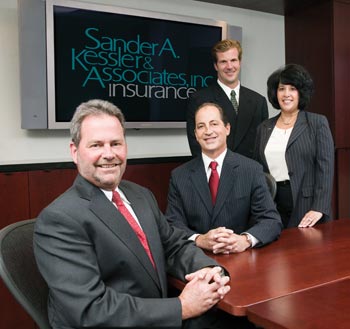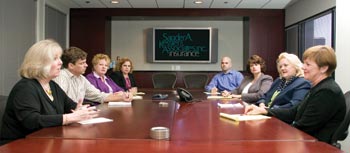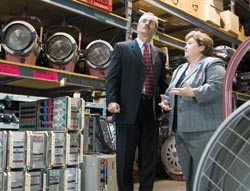|
MARKETING AGENCY OF THE MONTH Turning the corner Kessler's leadership uses tenacious focus to alchemize adversity into success By Dennis H. Pillsbury
“The good things which belong to prosperity are to be wished, but the good things that belong to adversity are to be admired.” Certainly, Sander A. Kessler & Associates, Santa Monica, California, was wishing for prosperity and had achieved it from its founding in 1956 up through 1995, when open rating came to California and “dramatically reduced rates and ultimately, revenue to our firm,” says Steven K. Kessler, CEO. “We experienced some very tough times and actually lost money in both 1997 and 1998. It was clear that we had to do something to turn things around.” Today, the agency is highly profitable and has revenues of $17 million and is on target to achieve the goal established in its latest five-year plan of reaching $20 million in revenue by May 31, 2007, with a pre-tax profit of 15%. Obviously, good and admirable things have been achieved as the management team successfully navigated the agency through the perilous waters between the legendary Scylla and Charybdis where one wrong turn could have transmuted adversity into total disaster. The agency was founded by Steve and Ken’s father, “Sandy,” who continues to serve as chairman, although he is not active and no longer is a stockholder. Kenneth L. Kessler is president. Ken and Steve, along with Joel Davidowski, executive director, benefits department, and Lucille Shalometh, executive vice president/sales manager, make up the active leadership of the agency. The leadership had a lot to do. The first step, according to Steve, “was to get very focused on what we, the leadership of the organization, do best” so they could effectively create and follow through on a plan of action. The result was that Steve became responsible for the business aspects of the agency; Ken oversees the revenue activities as well as the entire marketing effort of the agency’s P&C book. He is also responsible for all P&C carrier relations. He handles difficult placements and is the workers comp guru of the firm; Lucille leads the sales effort and she has doubled the new business sales in P&C in the last two years. Joel is the visionary of the benefits department, making certain that the benefits area continues to grow and is part of the agency’s overall cross-selling strategy. (Benefits currently accounts for more than $4 million of the agency’s revenue and is the fastest growing revenue department of the firm.) Each of the four members of Leadership is responsible for a significant book of business—Ken, $2 million in revenue; Joel, $2 million; Lucille $1.2 million and Steve about $1 million. In addition, Ron Bloom, vice chairman and past president, also maintains a very large and complicated book of about $1.7 million in revenue. Mel Moss, senior vice president and a previous stockholder, maintains a book in excess of $1.1 million. At the same time, the leadership also had to make some tough decisions designed to get expenses in line with the lower revenues that had resulted from the 1995 reforms. The goal was to bring payroll and payroll-related expenses well below 70% of revenues. A number of under-productive people were let go, including one highly compensated partner who “we felt was more focused on the top line versus the bottom line,” Steve says. The agency also closed a large unprofitable division. This division offered program pricing and loss control services and, although it brought in significant revenues, it also was responsible for an inordinate amount of expense internally as well as externally. Eliminating the division saved more than $800,000 in loss control-related expenses, not to mention a significant amount of internal payroll expenses. Account stratification “We also stratified our accounts into precious metal categories: platinum for accounts producing more than $125,000 in revenue; gold for $50,000 to $124,999; and silver for accounts from $20,000 to $49,999,” Steve points out. “This allowed us to focus our services for each of those categories—again with an emphasis on correlating revenues and expenses.” In some cases, the agency found that services fell short of what clients should expect so “we make sure by audit that those services are delivered,” Steve says. “We do an action plan at the beginning of the policy year that is shared with the client. Four months prior to renewal, we produce a stewardship report that shows how we performed. We also include information concerning what can be expected in terms of rates at renewal time.” Joel notes that: “Today, this is especially important in the benefits area. We negotiate renewals 120 days in advance and are able to warn the CFO or business owner ahead of time about any rate increases. It gives them time to modify plans if necessary.”
Maintaining focus Steve adds, “One of our advantages is our ability to remain focused on our profitability goal. That did not come easily. So we have taken steps to make certain that we always remain on track. Strategic planning was one of the keys that started us heading in the right direction and we never want to lose the focus that has brought to our leadership. “We engage in strategic planning religiously, with the four active members of Leadership meeting every quarter with our CFO, CPA, and other outside consultants, including personnel from Marsh Berry. After each meeting, we produce a task list of various assignments designed to keep us headed in the right direction.”
Ken adds that the agency has refocused its sales effort in areas that are more productive for the agency. Referrals, rounding out accounts, and cross-selling accounts, supplemented by telemarketing reps, has proven to be a more effective and productive means of producing business. In fact, “cross-selling has been one of the significant contributors to our success. We have done remarkably well in cross-selling between benefits to property/casualty accounts and vice versa which is being driven by Lucille. In the past few years, we have written more than $2 million a year in new business via cross-selling. Our hit ratio has gone from the low 30 percentile to the low 60s.” In addition to the sales and telemarketing responsibilities, Lucille has taken over the cross-sell effort in “our private client (personal lines department) services which also has been an extremely important—and profitable—part of our cross-selling effort,” Ken adds. “We write the principals and other top-level people at our accounts.” Steve adds, “Team selling has become our way of doing business. It has helped in the area of cross-selling, but also in terms of client retention. Each producer has a team behind him or her who supports the sales and service effort. Since we guarantee our service effort at the beginning of the policy year, it’s important for us to have the people on board who can support that effort. We have eight claims people, with four of those solely for workers compensation. We also have our own in-house risk manager and a loss control person, as well as a human resources expert that is available on an outsourced basis.” Carrier relationships Ken says that carrier relationships have been a strategic initiative for the agency. He adds that “we have worked hard to develop relationships that are mutually beneficial to the carriers and to Kessler. This philosophy is maintained in all divisions of the firm, including the vendors whom we do business with.” The agency focuses on heavy industry and other “difficult” accounts where service and expertise in loss control can play integral roles in getting and keeping accounts. “We got our start by writing the meat and food-service industries where workers compensation represents the largest part of their insurance needs,” Steve says. “And we continue to focus on those areas, using the expertise we developed to help them control losses. “About 55% to 60% of our volume is workers compensation,” he continues. “And it is sometimes quite volatile, so we help our clients deal with that volatility by providing seminars on loss control and other risk management concerns, including aggressive claims handling by the client. We specialize in taking accounts that have a debit mod and help them reduce their costs. We stay on top of claims when they occur and provide quarterly claims reviews, including unit stat reviews, so clients can make effective risk management decisions that will reduce losses.”
The role of technology Technology is a very important component in Kessler’s success. “We invest heavily in technology,” Steve says. “Our agency management system is AMS’s AfW and through it we maintain everything about our clients in our database. We use desktop faxing and are moving into document management so that we will be basically paperless. Technology has been key in helping us generate our stewardship reports. “Technology also has allowed us to expand our services to clients and to protect ourselves in the event of a catastrophe,” Steve adds. “We maintain a hotspot, an off-site location that is available in the event of a major catastrophe.” This off-site location includes 15 workstations as well as servers, printers, laptops and a generator. “It has everything we need in the event our building can’t be used.” The measure of their success Kessler worked with Marsh Berry and its APPEX organization to determine where it stood in relation to other agencies and also to identify ways to improve. Steve admits that it was embarrassing, but also edifying, to learn that the agency’s Performance Indicator Number in 1999 was 4.61, well below the average of 5.80. The best was 8.04. Today, the agency is well above the average and approaching the numbers of the best. Steve says, “We have learned a lot from the successful agencies that are part of APPEX and from the people at Marsh Berry who have helped us with our turnaround. The numbers speak for themselves. “However, probably the most important lesson is the constant reminder to celebrate our successes with our staff. We would not be where we are today, and we would not be able to achieve any of our goals in the future, were it not for the tremendous people who make up this agency. They have truly helped us live up to our mission statement ‘to be recognized as the most progressive, dynamic and rapidly growing firm in the insurance marketplace, focused on exceeding client, colleague and carrier expectations.’ As a result, we have created the Kirsch Kup award, named in honor of one of our most beloved and respected associates who joined the firm in the middle ’60s and passed away a couple of years ago,” Steve explains. “ ‘Bernie’, who we all loved and admired, exemplified our vision and values. We give this award at the end of our fiscal year to the associate with the most nominations collected during the year demonstrating our mission statement, vision and values. “The award includes a $5,000 bonus plus underground parking for a year along with their name inscribed on a beautiful trophy prominently displayed in our lobby. In addition, we have created a bonus system for all managers and associates based on specific strategic initiatives. Each manager formulates five strategic initiatives at the beginning of the fiscal year, which are reviewed and approved by me,” Steve continues. “We then meet every other month to check on the progress of their plan, roadblocks, etc. If the agency meets its renewal retention goals, new business goals and, most important, profit goals, the staff is eligible for their bonus. If the managers hit their five strategic objectives, they are eligible for their bonus, which is substantial. The most imporant component is that we hit our profit goal,” Steve concludes. Sander A. Kessler & Associates exemplifies the values of service to clients and care for employees that makes us proud to recognize the agency as this month’s Rough Notes Marketing Agency of the Month. * |
||||||||
|






